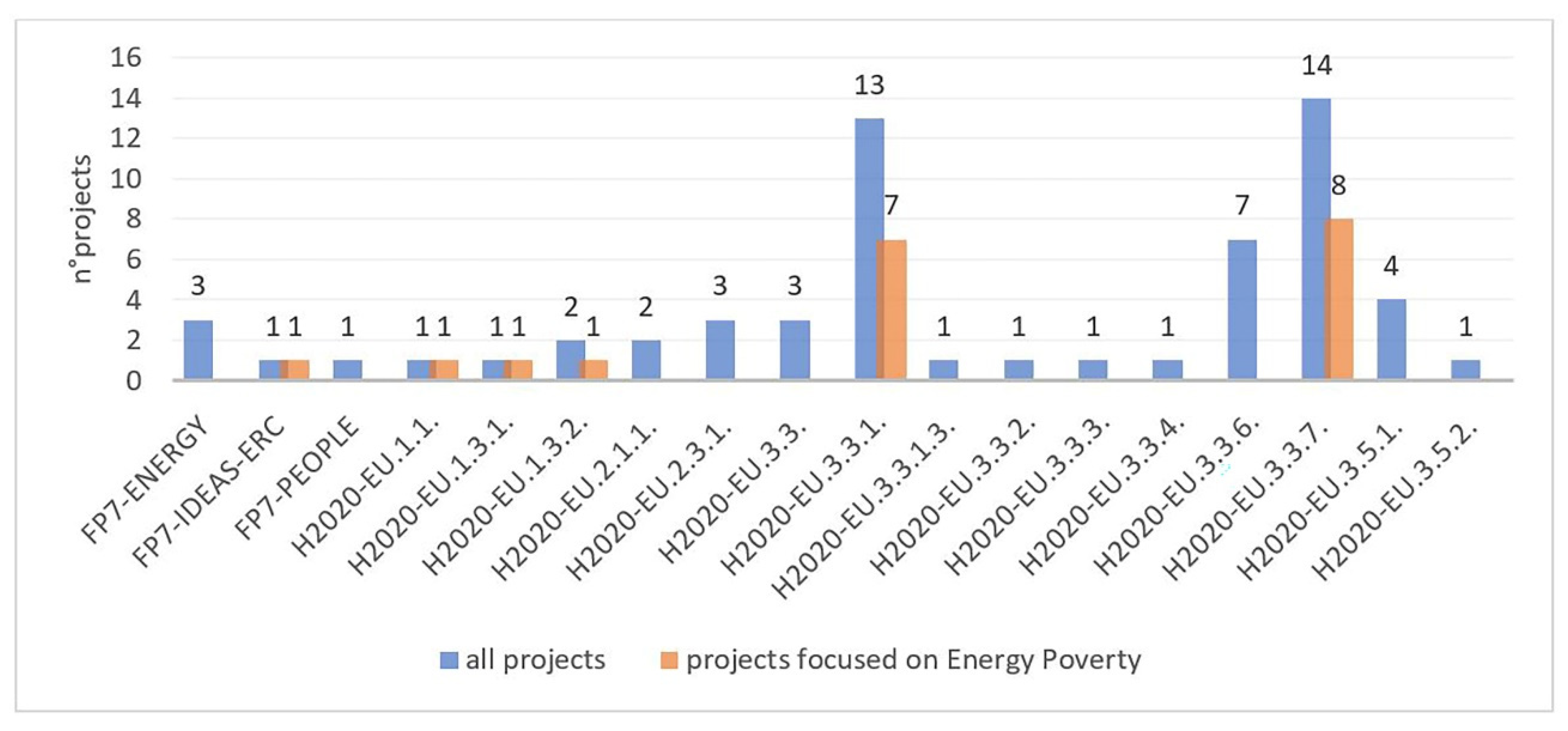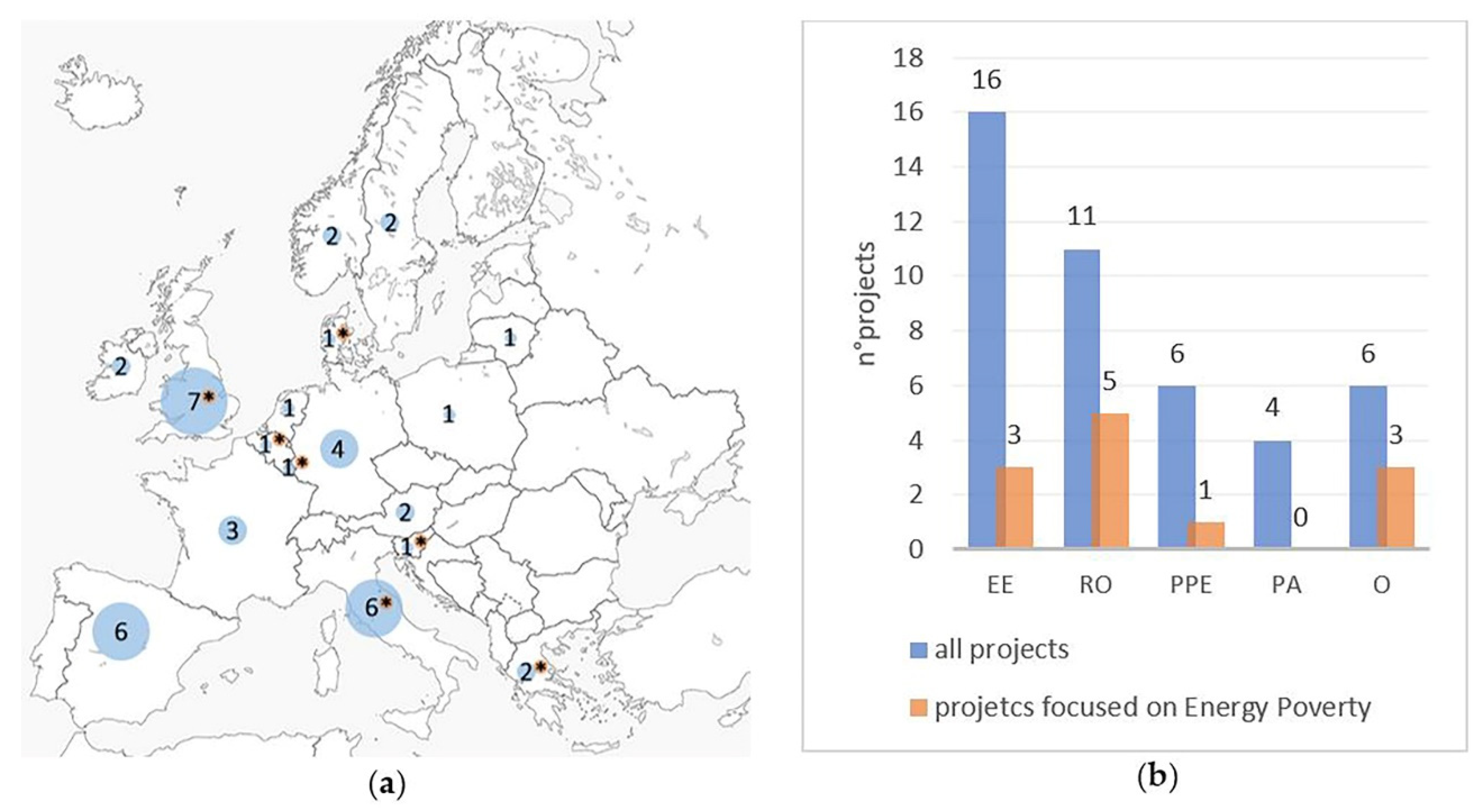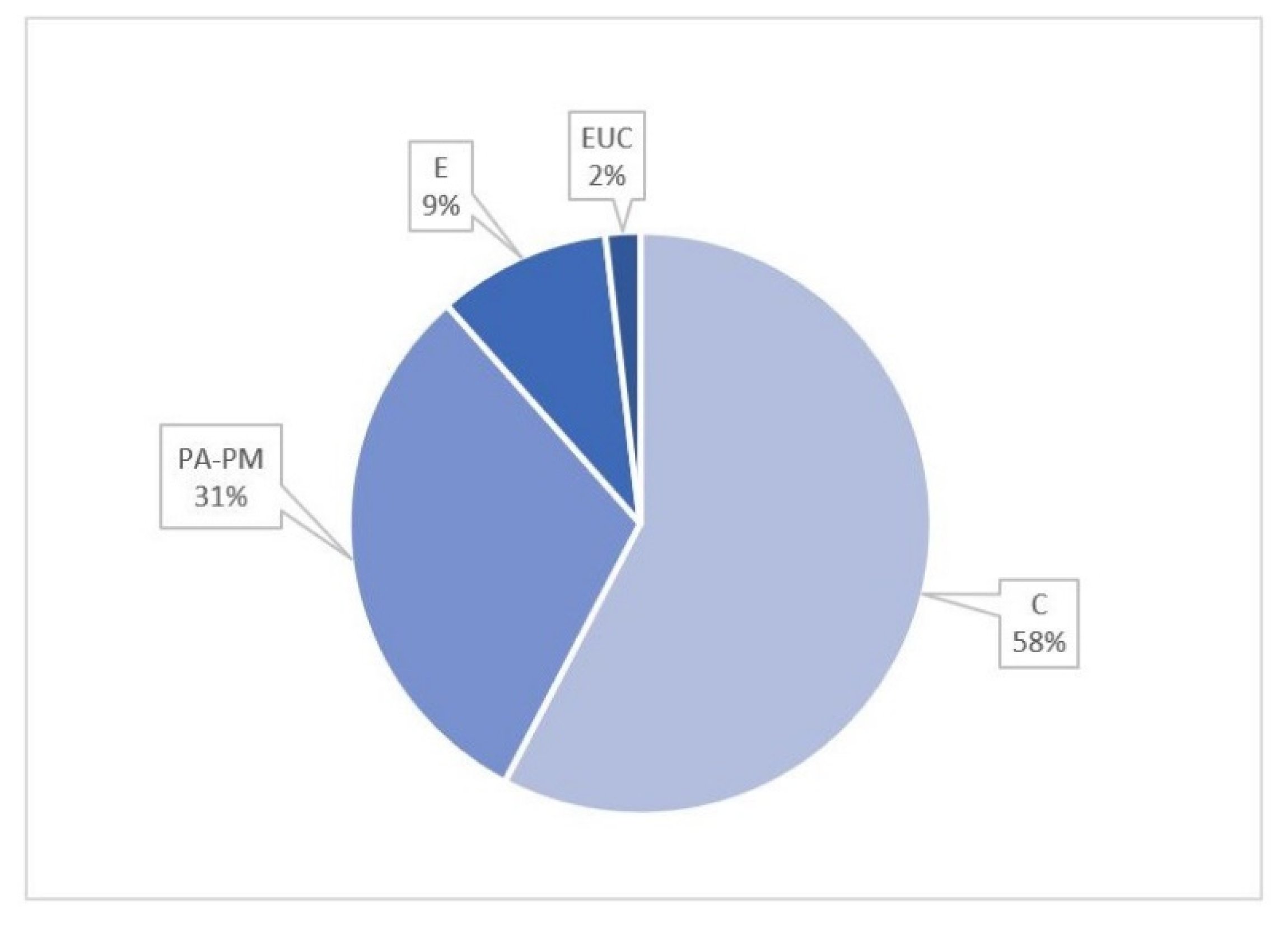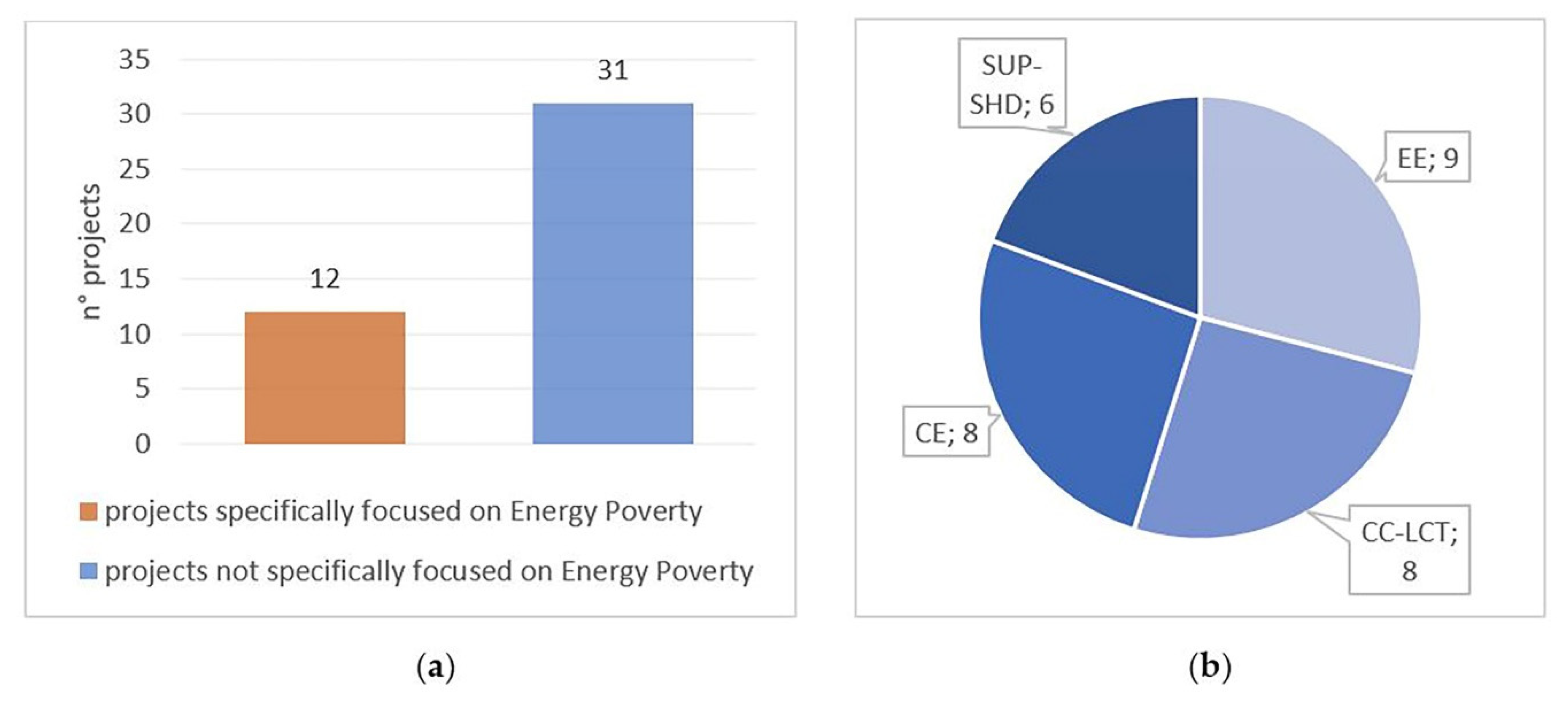Energy Poverty and Protection of Vulnerable Consumers. Overview of the EU Funding Programs FP7 and H2020 and Future Trends in Horizon Europe
Abstract
1. Introduction
2. Objectives and Methodology
- Engager—European energy poverty: agenda cocreation and knowledge innovation (2017–2022)—funded by the European Cooperation in Science and Technology organization (COST);
- EPOV—the EU Energy Poverty Observatory (2016–2019)—initiative by the European Commission;
- Evaluate—energy vulnerability and urban transitions in Europe (2013–2018)—funded by the European Research Council;
- EPEE—European fuel poverty and energy efficiency (2006–2009)—IEE funded project.
- Energy poverty;
- Fuel poverty;
- Energy vulnerability;
- Vulnerable consumers;
- Vulnerable households.
3. Projects Results—Systematization and Comparison
3.1. Selected FP7 and H2020 Projects Dealing with Energy Poverty Issues
3.2. Comparison and Filling Results
- facilitating behavioral change and implementation of low-cost energy efficiency measures tailored for energy poor households;
- supporting the set-up of financial and nonfinancial support schemes for energy efficiency and/or small-scale renewable energy investments for energy poor households;
- developing, testing, and disseminating innovative schemes for energy efficiency/renewable electricity sources (RES) investments established by utilities or other obligated parties under Article 7 (of Energy Efficiency Directive 2012/27/EU) [29].New projects are expected in the coming years, funded by the Calls for Proposals 2019 and 2020.
- Citizens engagement—involvement of vulnerable consumers in order to improve their awareness, to guide them in the adoption of behavioral changes aimed at reducing energy consumption and to support them in the digitization process;
- Climate change and low-carbon transition—policies and actions to tackle climate change and its impacts without negative repercussions on vulnerable citizens; initiatives to fulfil the key objectives of the European Strategic Energy Technology Plan (SET Plan);
- Energy efficiency—developing and monitoring technological solutions for Near Zero Energy Buildings (NZEB) and building retrofitting. Solutions involve the development of plant systems, building components, and technological systems to reduce consumption and generate energy savings;
- Sustainable urban planning and social housing districts—strategies towards urban planning renovation, regeneration of public spaces, social housing and vulnerable districts, and the pursuit of nearly zero energy cities.
4. Open Issues and Future Trends
5. Conclusions
Author Contributions
Funding
Conflicts of Interest
Appendix A
| n° | Acronym | Period | Description |
| 01 | STEP-UP | 2012–2015 | Strategies Towards Energy Performance and Urban Planning |
| 02 | EVALUATE * | 2013–2018 | Energy Vulnerability and Urban Transitions in Europe |
| 03 | R2CITIES | 2013–2017 | Renovation of Residential urban spaces: towards nearly zero energy cities |
| 04 | PACE | 2013–2015 | Property Assessed Clean Energy |
| 05 | INSIGHT_E | 2014–2017 | Interdisciplinary Strategic Intelligence wareHouse and Think-tank for Energy |
| 06 | REMOURBAN | 2015–2019 | REgeneration MOdel for accelerating the smart URBAN transformation |
| 07 | USES * | 2015–2018 | Understanding Social-Ecological Systems: Coupling population and satellite remotely sensed environmental data to improve the evidence base for sustainable development |
| 08 | SMARTESS | 2015–2021 | Social innovation Modelling Approaches to Realizing Transition to Energy Efficiency and Sustainability Innovate |
| 09 | GREEN-WIN | 2015–2018 | Green growth and win-win strategies for sustainable climate action |
| 10 | QBOT | 2015–2017 | Fast and economic insulation of buildings using robotic systems |
| 11 | CD-LINKS | 2015–2019 | Linking Climate and Development Policies—Leveraging International Networks and Knowledge Sharing |
| 12 | ENTRUST | 2015–2018 | Energy System Transition Through Stakeholder Activation, Education, and Skills Development |
| 13 | SMART-UP | 2015–2018 | Vulnerable consumer empowerment in a smart meter world |
| 14 | EnerGAware | 2015–2018 | Energy Game for Awareness of energy efficiency in social housing communities |
| 15 | COMBI | 2015–2018 | Calculating and Operationalizing the Multiple Benefits of Energy Efficiency Improvements in Europe |
| 16 | Decent Living Energy * | 2015–2019 | Energy and emissions thresholds for providing decent living standards to all |
| 17 | LEMON * | 2015–2020 | LEMON Less Energy More OpportuNities |
| 18 | TRIBE | 2015–2018 | TRaIningBehaviors towards Energy efficiency: Play it! |
| 19 | REEM | 2016–2019 | Role of technologies in an energy efficient economy—model-based analysis of policy measures and transformation pathways to a sustainable energy system |
| 20 | Think Nature | 2016–2019 | Renovation of Residential urban spaces: Towards nearly zero energy CITIES |
| 21 | ABRACADABRA | 2016–2019 | Assistant Buildings’ addition to Retrofit, Adopt, Cure, and Develop the Actual Buildings up to zeRo energy, Activating a market for deep renovation |
| 22 | ECHOES | 2016–2019 | Energy CHOices supporting the Energy union and the Set-plan |
| 23 | EnerSHIFT * | 2016–2020 | Energy Social Housing Innovative Financing Tender |
| 24 | ENERGISE | 2016–2019 | European Network for Research, Good Practice, and Innovation for Sustainable Energy |
| 25 | ENABLE.EU | 2016–2019 | Enabling the Energy Union through understanding the drivers of individual and collective energy choices in Europe |
| 26 | INNOPATHS | 2016–2020 | Innovation pathways, strategies, and policies for the Low-Carbon Transition in Europe |
| 27 | SAVES2 * | 2017–2020 | Students Achieving Valuable Energy Savings 2 |
| 28 | EnergyKeeper | 2017– 2019 | Keep the Energy at the right place! |
| 29 | ASSIST * | 2017–2020 | ASSIST - Support Network for Household Energy Saving |
| 30 | AirEX | 2017–2018 | Smart Ventilation Control |
| 31 | SOLACE | 2017–2017 | System of production and delivery self-assembly, carbon neutral, energy positive, and income generating house, which reduces housing overburden declining inequality gap |
| 32 | AZEB | 2017–2020 | Affordable zero energy buildings |
| 33 | InBETWEEN | 2017–2020 | ICT enabled BEhavioral change ToWards Energy EfficieNt lifestyles |
| 34 | PV-Prosumers4Grid | 2017–2020 | Development of innovative self-consumption and aggregation concepts for PV Prosumers to improve grid load and increase market value of PV |
| 35 | TRANSFAIR | 2018–2020 | Unfair transitions? A critical examination low-carbon energy pathways in the EU from a domestic energy vulnerability perspective |
| 36 | STEP-IN * | 2018–2020 | Using Living Labs to roll out Sustainable Strategies for Energy Poor Individuals |
| 37 | SCORE | 2018–2021 | Supporting Consumer Co-Ownership in Renewable Energies |
| 38 | STEP * | 2019–2021 | Solution to Tackle Energy Poverty |
| 39 | EmpowerMed * | 2019–2023 | Empowering women to take action against energy poverty in the Mediterranean |
| 40 | SocialWatt * | 2019–2022 | Connecting Obligated Parties to Adopt Innovative Schemes towards Energy Poverty |
| 41 | ODYSSEE-MURE | 2019–2021 | Monitoring EU energy efficiency first principle and policy implementation |
| 42 | Smart BEEjs * | 2019–2023 | Human-Centric Energy Districts: Smart Value Generation by Building Efficiency and Energy Justice for Sustainable Living |
| 43 | HIROSS4all | 2019–2022 | Home integrated renovation one-stop-shop for vulnerable districts |
References
- European Parliament. Directive 2009/72/ECof the European Parliament and of the Council of 13 July 2009 Concerning Common Rules for the Internal Market in Electricity and Repealing Directive 2003/54/EC; European Parliament: Brussels, Belgium, 2009. [Google Scholar]
- European Parliament. Directive 2009/73/EC of the European Parliament and of the Council of 13 July 2009 Concerning Common Rules for the Internal Market in Natural Gas and Repealing Directive 2003/55/EC; European Parliament: Brussels, Belgium, 2009. [Google Scholar]
- Third Energy Package. 2009. Available online: https://ec.europa.eu/energy/en/topics/markets-and-consumers/market-legislation (accessed on 29 December 2019).
- European Economic and Social Committee (EESC). Opinion of the European Economic and Social Committee ‘for Coordinated European Measures to Prevent and Combat Energy Poverty’. Off. J. Eur. Union 2013, 56, 1–8. [Google Scholar] [CrossRef]
- Trinomics, Selecting Indicators to Measure Energy Poverty. 2016. Available online: https://ec.europa.eu/energy/sites/ener/files/documents/Selecting%20Indicators%20to%20Measure%20Energy%20Poverty.pdf (accessed on 28 December 2019).
- Insight_E. Policy Report, Energy Poverty and Vulnerable Consumers in the Energy Sector across the EU: Analysis of Policies and Measures. 2015. Available online: https://ec.europa.eu/energy/sites/ener/files/documents/INSIGHT_E_Energy%20Poverty%20-%20Main%20Report_FINAL.pdf (accessed on 18 January 2020).
- Bouzarovski, S. Energy Poverty. (Dis)Assembling Europe’s Infrastructural Divide, 1st ed.; Palgrave Macmillian: London, UK, 2018. [Google Scholar] [CrossRef]
- Thomson, H.; Bouzarovski, S. Addressing Energy Poverty in the European Union: European State of Play and Action; EU Energy Poverty Observatory (EPOV): Brussels, Belgium, 2019; Available online: https://www.energypoverty.eu/sites/default/files/downloads/observatory-documents/19-06/paneureport2018_updated2019.pdf (accessed on 20 January 2020).
- Bouzarovski, S. Energy Poverty in the European Union: Landscapes of Vulnerability. WIREs Energy Environ. 2014, 3, 276–289. [Google Scholar] [CrossRef]
- Fowler, T.; Southgate, R.J.; Waite, T.; Harrell, R.; Kovats, S.; Bone, A.; Murray, V. The Health Impacts of Cold Homes and Fuel Poverty. Eur. J. Public Health 2015, 25, 339–345. [Google Scholar] [CrossRef] [PubMed]
- European Fuel Poverty and Energy Efficiency Project (EPEE). 2009. Available online: https://ec.europa.eu/energy/intelligent/projects/sites/iee-projects/files/projects/documents/epee_european_fuel_poverty_and_energy_efficiency_en.pdf (accessed on 18 January 2020).
- European Commission. An Energy Policy for Customers. In Commission Staff Working Paper; European Commission: Brussels, Belgium, 2010; Available online: https://ec.europa.eu/energy/sites/ener/files/documents/sec%282010%291407.pdf (accessed on 15 January 2020).
- Boardman, B. Fuel Poverty: From Cold Homes to Affordable Warmth; Belhaven Press: London, UK, 1991. [Google Scholar]
- European Commission. Clean Energy for All European; Publications Office of the European Union: Brussels, Belgium, 2019; Available online: https://op.europa.eu/en/publication-detail/-/publication/b4e46873-7528-11e9-9f05-01aa75ed71a1/language-en?WT.mc_id=Searchresult&WT.ria_c=null&WT.ria_f=3608&WT.ria_ev=search (accessed on 27 January 2020).
- European Commission. United in Delivering the Energy Union and Climate Action-Setting the Foundations Fora Successful Clean Energy Transition. 2019. Available online: https://eur-lex.europa.eu/legal-content/EN/TXT/PDF/?uri=CELEX:52019DC0285&from=EN (accessed on 22 January 2020).
- Bouzarovski, S.; Petrova, S. A Global Perspective on Domestic Energy Deprivation: Overcoming the Energy Poverty-Fuel Poverty Binary. Energy Res. Soc. Sci. 2015, 10, 31–40. [Google Scholar] [CrossRef]
- European Union Statistics on Income and Living Conditions (EU-SILC). Available online: https://ec.europa.eu/eurostat/web/microdata/european-union-statistics-on-income-and-living-conditions (accessed on 17 February 2020).
- Simcock, N.; Petrova, S. Energy poverty and vulnerability: A geographic perspective. In Handbook on the Geographies of Energy; Solomon, B.D., Calvert, K.E., Eds.; Edward Elgar: Cheltenham, UK, 2017; pp. 425–437. [Google Scholar]
- Faiella, I.; Lavecchia, L.; Miniaci, R.; Valbonesi, P. Rapporto OIPE sulla povertà energetica in Italia. In Proceedings of the La Povertà Energetica in Italia: Come Misurarla e Come Combatterla, Milano, Italy, 4 June 2019. [Google Scholar]
- IEA. World Energy Outlook. 2017. Available online: https://www.iea.org/reports/world-energy-outlook-2017 (accessed on 10 January 2020).
- European Commission. EU Reference Scenario 2016: Energy Transport and GHG Emissions Trends to 2050. Available online: https://ec.europa.eu/energy/sites/ener/files/documents/20160713%20draft_publication_REF2016_v13.pdf (accessed on 22 January 2020).
- EU Regulation 2018/1999 of the European Parliament and of the Council of 11 December 2018, on the Governance of the Energy Union and Climate Action, Official Journal of the European Union 328/1, point (d) of Article 3(3) of Regulation (EU) 2018/1999. Available online: https://eur-lex.europa.eu/legal-content/EN/TXT/PDF/?uri=CELEX:32018R1999&from=EN (accessed on 21 January 2020).
- Gangale, F.; Mengolini, A. Energy Poverty through the Lens of EU Research and Innovation Projects; Publications Office of the European Union: Luxembourg, Belgium, 2019; p. 2. [Google Scholar] [CrossRef]
- Hills, J. Getting the Measure of Fuel Poverty: Final Report of the Fuel Poverty Review; CASEreport, 72; London School of Economics and Political Science: London, UK, 2012; Available online: https://eprints.lse.ac.uk/43153/1/CASEreport72%28lsero%29.pdf (accessed on 10 January 2020).
- European Structural and Investment Funds (ESIF). Available online: https://ec.europa.eu/info/funding-tenders/funding-opportunities/funding-programmes/overview-funding-programmes/european-structural-and-investment-funds_en (accessed on 22 January 2020).
- Report on the First Results of H2020 Projects on Energy Efficiency and System Integration-Final Report. 2017. Available online: https://ec.europa.eu/energy/sites/ener/files/documents/ed62228_h2020_energy_evaluation_final_report_v1.5_3_0.pdf (accessed on 22 January 2020).
- EU Energy Poverty Observatory (EPOV). Brief Overview of the EU Discourse on Fuel Poverty and Energy Poverty. 2014. Available online: https://www.energypoverty.eu/news/brief-overview-eu-discourse-fuel-poverty-energy-poverty (accessed on 18 January 2020).
- Horizon 2020 Work Programme 2018–2020, Secure, Clean and Efficient Energy. Available online: https://ec.europa.eu/research/participants/data/ref/h2020/wp/2018-2020/main/h2020-wp1820-energy_en.pdf (accessed on 20 January 2020).
- European Parliament. Directive 2012/27/EU of the European Parliament and of the Council of 25 October 2012 on Energy Efficiency, Amending Directives 2009/125/EC and 2010/30/EU and Repealing Directives 2004/8/EC and 2006/32/EC; European Parliament: Brussels, Belgium, 2012. [Google Scholar]
- Guidance Document on Vulnerable Consumers. 2013. Available online: https://ec.europa.eu/energy/sites/ener/files/documents/20140106_vulnerable_consumer_report_0.pdf (accessed on 20 January 2020).
- Temporary Working Group on Smart Solutions for Energy Consumers, SET-Plan 3.1 Energy Consumers Implementation Plan. 2018. Available online: https://setis.ec.europa.eu/system/files/set_plan_consumers_implementation_plan.pdf (accessed on 15 January 2020).
- Temporary Working Group on Smart Cities and Communities, SET-Plan 3.2 Europe to Become a Global Role Model in Integrated, Innovative Solutions for the Planning, Deployment, and Replication of Positive Energy Districts. 2018. Available online: https://setis.ec.europa.eu/system/files/setplan_smartcities_implementationplan.pdf (accessed on 20 January 2020).
- Thomson, H.; Snell, C.; Liddell, C. Fuel poverty in the European Union: A concept in need of definition. People Place Policy 2016, 10, 5–24. [Google Scholar] [CrossRef]
- Dobbins, A.; Fuso Nerini, F.; Deane, P.; Pye, S. Strengthening the EU response to energy poverty. Nat. Energy 2019, 4, 2–5. [Google Scholar] [CrossRef]
- Deller, D. Energy affordability in the EU: The risks of metric driven policies. Energy Policy 2018, 119, 168–182. [Google Scholar] [CrossRef]
- Grevisse, F.; Brynart, M. Energy poverty in Europe: Towards a more global understanding. Eur. Counc. Energy Effic. Econ. 2011, 71, 537–549. [Google Scholar]
- Faiella, L.; Lavecchia, L.; Borgarello, M. Una nuova misura della povertà energetica delle famiglie. Bank Italy Occas. Pap. 2017, 404. [Google Scholar] [CrossRef]
- Climate-KIK. Municipality-led Circular, Economy Case Studies. 2018. Available online: https://www.climate-kic.org/wp-content/uploads/2019/01/Circular-Cities.pdf (accessed on 15 January 2020).
- Interreg Europe. Renewable Energy Community. A Policy Brief from the Policy Learning Platform on Low-Carbon Economy. 2018. Available online: https://www.climate-kic.org/wp-content/uploads/2019/01/Circular-Cities.pdf (accessed on 15 January 2020).
- Orientations towards the First Strategic Plan for Horizon Europe. Available online: https://ec.europa.eu/info/sites/info/files/research_and_innovation/strategy_on_research_and_innovation/documents/ec_rtd_orientations-he-strategic-plan_122019.pdf (accessed on 15 January 2020).







| ACRONYM—Description | |
|---|---|
| Program(s) Topic(s) Call for proposal | Funding scheme Start date End date |
| Coordinator Partners Involved countries Target groups | |
| Objectives Methodology Expected results Outputs application scale | |
| Energy poverty perspective and/or related topics addressed in the project Energy poverty assumed definition Indicators | |
| Case study (if present) Geographic position (country/region/city/district) Type (private housing/social housing/nonresidential buildings/systems etc.) Purpose/Outputs | |
| Data Sources | Links |
© 2020 by the authors. Licensee MDPI, Basel, Switzerland. This article is an open access article distributed under the terms and conditions of the Creative Commons Attribution (CC BY) license (http://creativecommons.org/licenses/by/4.0/).
Share and Cite
Longo, D.; Olivieri, G.; Roversi, R.; Turci, G.; Turillazzi, B. Energy Poverty and Protection of Vulnerable Consumers. Overview of the EU Funding Programs FP7 and H2020 and Future Trends in Horizon Europe. Energies 2020, 13, 1030. https://doi.org/10.3390/en13051030
Longo D, Olivieri G, Roversi R, Turci G, Turillazzi B. Energy Poverty and Protection of Vulnerable Consumers. Overview of the EU Funding Programs FP7 and H2020 and Future Trends in Horizon Europe. Energies. 2020; 13(5):1030. https://doi.org/10.3390/en13051030
Chicago/Turabian StyleLongo, Danila, Giulia Olivieri, Rossella Roversi, Giulia Turci, and Beatrice Turillazzi. 2020. "Energy Poverty and Protection of Vulnerable Consumers. Overview of the EU Funding Programs FP7 and H2020 and Future Trends in Horizon Europe" Energies 13, no. 5: 1030. https://doi.org/10.3390/en13051030
APA StyleLongo, D., Olivieri, G., Roversi, R., Turci, G., & Turillazzi, B. (2020). Energy Poverty and Protection of Vulnerable Consumers. Overview of the EU Funding Programs FP7 and H2020 and Future Trends in Horizon Europe. Energies, 13(5), 1030. https://doi.org/10.3390/en13051030








